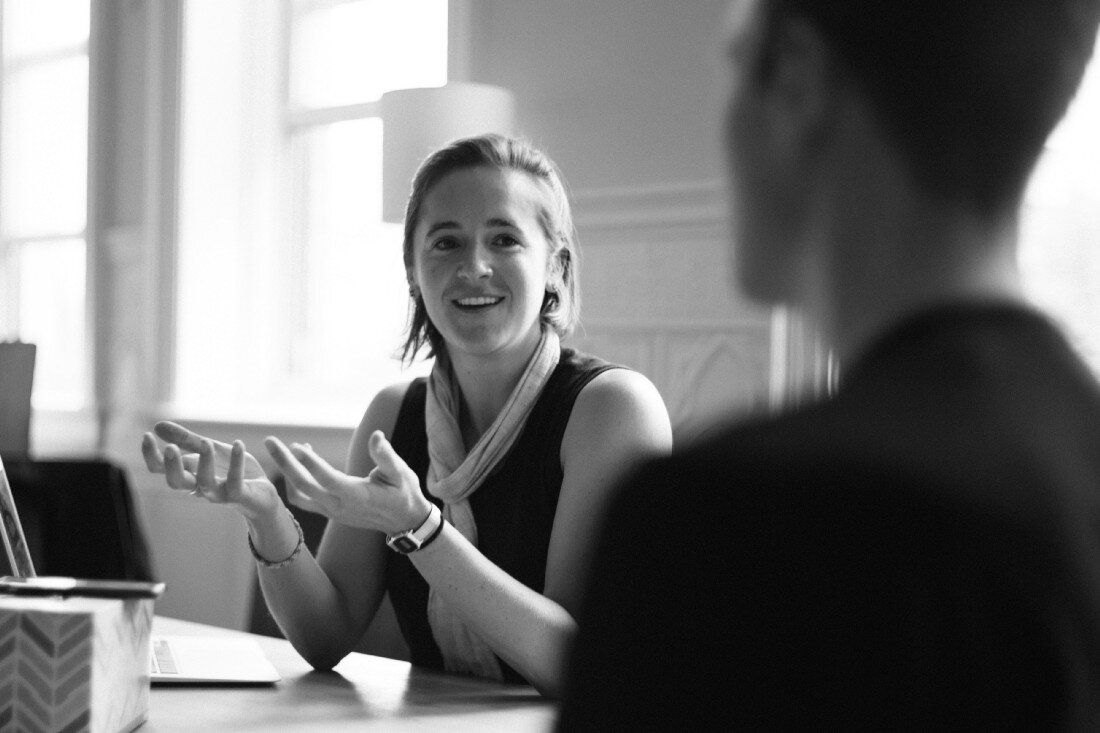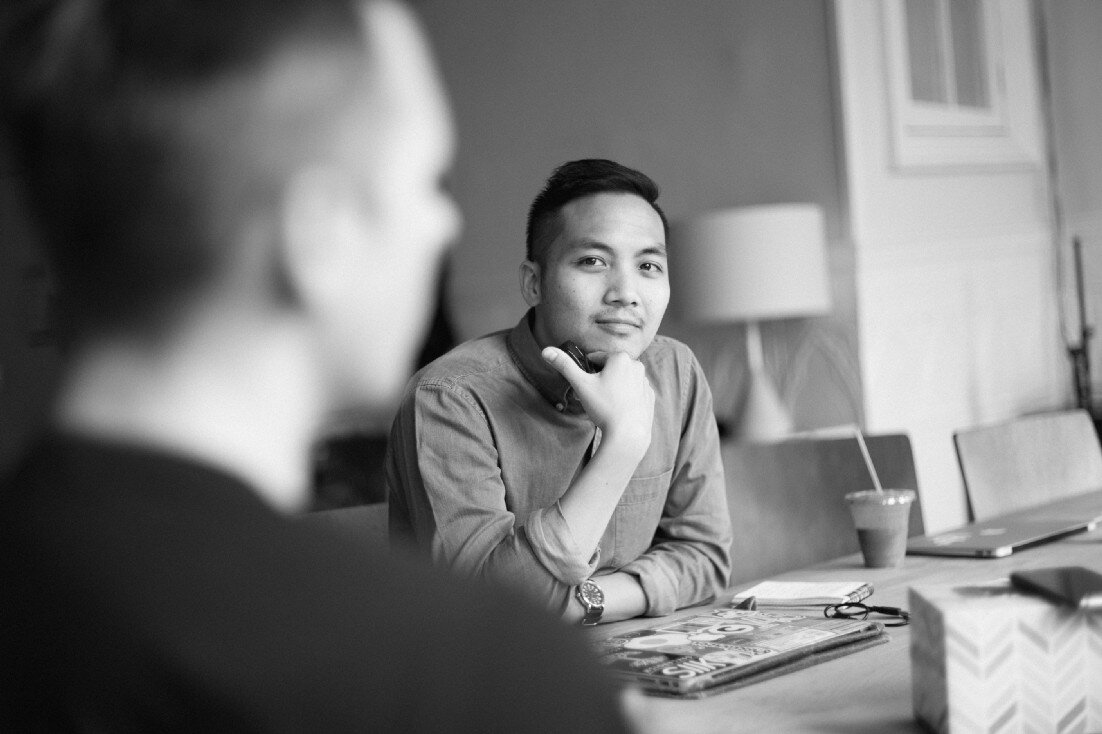How Ryan Fitzgibbon built Hello Mr. hand-in-hand with its community.
The sincerity of the magazine’s content connected deeply with a group of people who have propelled Hello Mr. forward.
I met Ryan Fitzgibbon two years ago. At the time, I was a resident at the design firm IDEO and had just made their very first zine. As a past IDEO-er and the founder of Hello Mr. magazine, Ryan took notice and reached out.
Over coffee, I immediately developed an intellectual and creative crush on Ryan that’s proved long-lasting. Ryan is many beautiful polarities in one: discerning but open-minded, passionate but approachable, self-assured but demure.
And Hello Mr.—his magazine “About Men who Date Men”—is similarly special, as its audience clearly recognizes. Everywhere Ryan goes readers approach him to share how Hello Mr. has affected their lives for the better. He’s received so many Thank You notes and coming out letters in the mail that he recently made a small book of them. Now, he’s opening up a residency program to bring his audience even closer.
I wanted to learn more about the nitty gritty of how Ryan grew Hello Mr. from its very first subscriber to readers all around the world, and what’s kept the community so passionate along the way.
Below are the highlights from my conversation with Ryan, adapted for written text. If you want to learn even more from Ryan, check out the full interview or read the transcript here.
Listen to the full episode here.
Bailey Richardson: I’ve had the chance to see first-hand how much Hello Mr. means to the people who read it. It’s just incredible.
Where does your community’s passion come from, do you think?
Ryan Fitzgibbon: Hello Mr. was part of a bigger shift and a bigger movement. In 2011, I was living in San Francisco finishing up at IDEO. I noticed this growing trend in indie magazines, and at the same time the Proposition 8 and marriage equality conversations were picking up momentum.
But in the media and the press, all I was seeing of LGBTQ people was this idealized image of a family unit. I was 23, maybe 22, and that just didn't apply to me.
At the time, there wasn’t a solid publication for people to tell stories that were vulnerable and open to the mundane parts of being a gay man. The Hello Mr. content is very much about what it’s actually like to get broken up with and to go on a first date and come out. Those things people really resonated with because they were refreshing.
That’s what the rest of the world identifies us as, but do we identify with those things?
BR: It wasn’t just the content but also the way the magazine looks, right? You have such a strong background in graphic design and Hello Mr. embodies that.
RF: It was a personal challenge for me as a graphic designer and a brand junkie to look at the brand of LGBTQ people and say, “What are other symbols that we can relate to and see each other in that don’t come down to the same three or four things?” You have the shirtless go-go dancers on a Pride float waving a rainbow flag behind them with glitter on their face. Then you have the suited up men holding hands on the front of New York Times saying, “Love is love.” And the child carrying a protest sign saying, “I love my two moms.”
That’s what the rest of the world identifies us as, but do we identify with those things? It’s important that we stay true to these impactful symbols because they are our brand, but at the same we are evolving really quickly.
Even Hello Mr. has evolved since we launched. It’s now part of a tier of identifying as a certain type of person that holds a certain type of value. If you see someone reading Hello Mr. at a coffee shop or you go to someone’s house and it’s on their coffee table, there is something that instantly is said about who they are.
BR: That’s such an accomplishment for you as a designer to be able to appeal as a visual identity to so many people. It’s as if they are saying, “I’m not wearing a rainbow pin, but I’ll carry a Hello Mr. around.”
RF: In some of my early press when I was launching the magazine, I used the phrase “I’m rebranding the gay community,” which caused a lot of feathers to be ruffled. It was my way of saying, “We can do this without rainbow flags, but they aren’t going anywhere.”
We are a magazine about a specific type of person who identifies a specific type of way to their core.
It was a statement for me to not have rainbows anywhere in the magazine in the first issue. I’ve been criticized by people for being homophobic because of that, but I did it for the same reason I didn’t have advertisements in the first issue: Hello Mr. was my new vision and I didn’t want it to be impacted by something that people already have a construct of.
BR: Did you suspect that vision would resonate right from the start?
RF: One of the first things I decided on after the name, mission statement, and the visual characteristics of Hello Mr. was that tag line: “About Men who Date Men.”
We are a magazine about a specific type of person who identifies a specific type of way to their core. To label it as something more generic like “A gay lifestyle magazine” would have instantly put it in your mind as being something that you’ve seen before.
I started telling people about that concept and it just became so clear that people felt the need for this. It was almost like I didn’t have to explain because they understood immediately. That made it apparent that I needed to hurry up and make Hello Mr. happen.
BR: How did you get Hello Mr. from a concept to that first group of readers?
RF: Kickstarter was fairly fresh at the time, and I felt like it was a platform that was going to help amplify what we were aiming to do. I opened our crowdfunding campaign and opened submissions for the magazine on the same day.
The incoming was just out of control. We received over 100,000 words in submissions by the time that the Kickstarter was over. I think people were really feeling like there was a new place for them and they rushed in—like a body of water filling in a space.
BR: So many crowdfunding campaigns fall flat. How’d you create buzz around your Kickstarter?
RF: I had about 30% of the magazine complete when I launched the Kickstarter, so I was working with contributors that I admired and friends of mine already. They were almost accountable for Hello Mr. becoming a reality. That created a much more powerful group effort.
The press emerged from that group of contributors too, and it spread organically, but mostly because of controversy. One person wrote: “If you like your magazines with shirts on and bearded hipsters you should check this out.” But once one outlet wrote about us, a conversation was started. Their skepticism just created another channel for someone else to write about it, then another channel for someone else, and so on.
BR: So you launch your Kickstarter and you open up for submissions and people start flooding your inbox. You got your funding pretty quickly, right?
RF: No.
BR: It took awhile?
RF: Yeah, it took until the last day. It was a struggle. I didn’t have a clear sense of how to keep the Kickstarter campaign active throughout the 30-day span.
Then 48 hours before the campaign ended, Neil Patrick Harris randomly tweeted about it. It was the strongest endorsement that we had had to date and that got more people interested and involved.
So we had that funding, and we had a ton of content—so many illustrations and essays to go through. The curation happened from there.
BR: Did you ever question whether or not you had a critical mass of people to make Hello Mr. work?
RF: Totally. Sometimes I still do. Every time we announce something or host an event, it’s not always an immediate sell out. Things don’t fly off the shelves, but I think the people who it resonates with and who contribute to it have confirmed its value enough for me.
I have my thousand true fans and that maybe is enough. With that, I can hopefully do more over a sustained period of time.
BR: I remember the first time I saw a Hello Mr. I sensed there was something nascent about it—that I’d heard about it before or that Hello Mr. had already been orbiting me in some capacity.
RF: I’m sure Instagram was part of that. I started an account nine months before I launched the Kickstarter, so I was building momentum.
As soon as we had a physical object—and this is a huge part of why it’s print—people could hold it like a badge and could identify with it in the context of their home and their life.
Instead of being prescriptive, we want to reflect real life.
That was early Instagram days when people just were starting to compose their Instagrams—to put visual things like Hello Mr. out into the world in a way that communicated their identity. People made Hello Mr. viral without me having to do very much.
BR: Since launching the magazine, you’ve been tasked with evolving Hello Mr. so it continues to feel fresh and sincere.
How do approach that challenge?
RF: One of the things that I really struggled with is that the magazine industry at large is very prescriptive. The GQs of the world and the Men’s Health’s and Cosmos, they’re all about what you should do, where you should travel, what you should eat. Instead of being prescriptive, we want to reflect real life.
One way I get that inspiration is from who I follow on social media. I don’t look to influencers, instead I often look to young, interesting, unheard queer voices and see what they’re into and how they express themselves.
We are also out in the world hosting meetups and parties with our community and opening up our office to be more transparent. We want to be more accessible than traditional publications.
BR: I remember a story you published about a year ago that had pretty sexual photography, and you said to me, “I don’t know how my mom is gonna respond to this one.”
How do you balance what Hello Mr. covers—stretching people’s vision of your brand versus hitting on your core voice?
RF: It’s driven by the constantly evolving definition of our queer lives, which is complicated because it’s happening really fast. We’re constantly redefining ourselves.
Hello Mr. is still about men who date men. We draw our circle loosely around that, but we include voices and representation of other people within the LGBTQ community in ways that feel considered.
And we just launched a Kickstarter for a new residency. The goal is very much to be able to endorse and include voices that don’t fall under the category of “men who date men” or don’t want to be labeled as “Mr.”
People have often asked me to start a Hello Miss for women and because I don’t feel confident in being an expert in that, I haven’t. But this residency is a platform that will be able to open that up for people who do have the authority to speak up on behalf of their own specific communities.
BR: Ryan, I just have one more question for you. Hello Mr. is incredibly personal for so many people, and that’s perhaps true for you more than anyone else. What has it meant to you to run this magazine?
RF: One of the most powerful moments for me came in 2013. Barnes & Noble had just started distributing Hello Mr. to about 350 locations in North America.
There was Hello Mr. just sitting in the front being all coy and confident, very minimal and approachable.
One of the locations was in my hometown in Midland, Michigan. About 30,000 people live there, so it’s not the tiniest town, but as far as I’m concerned there are zero gay people. At least that’s what it felt like when I was growing up. [laughter]
The photograph Ryan’s mom took of Hello Mr. at a Barnes & Noble in his hometown.
Being a designer and a fan of magazines, I used to go to that Barnes & Noble and look for magazines. There weren’t any gay magazines for me. If I ever found any, they were in the bottom of the shelf, tucked under black plastic.
When Hello Mr. hit the shelf at the Barnes & Noble in my hometown, my mom went to go buy it and she sent me a photo of it on the front shelf. Every other magazine cover in that photo was a shirtless, oiled, chiseled man, and then there was Hello Mr. just sitting in the front being all coy and confident, very minimal and approachable. It just made me weep.
That whole narrative of my life was reflected back—getting my vision on shelves and also getting my mother to accept that and send a photo to me saying she’s proud of me.
There are a few people on my team who are not out to their parents and it’s intense for me to make them comfortable in this space and see their passion, because at one point they will be out to their parents. And at one point they will want to show their parents something that reframes their identity. That’s why I made Hello Mr. I didn’t create it just for us designers and illustrators and writers to sit around and kiki over brunch. People are being affected by this all around and it’s incredible to be a part of that.
Big thank you to Ryan Fitzgibbon for lending us his time and his brain. For more from Ryan and Hello Mr., tune into their Instagram, support their new residency on Kickstarter, or visit their website (and become a member!).
This case study was produced by the team at People & Company.
We published a book, host a podcast, and we work with organizations like Nike, Porsche, Substack and Surfrider as strategy partners, bringing confidence to how they’re building communities.
Stay up to date on all things Get Together.










